Morphology
| | This section is empty.You can help by adding to it.(August 2014) |
| Archegozetes longisetosus | |
|---|---|
| Scientific classification | |
| Kingdom: | |
| Phylum: | |
| Class: | |
| Subclass: | |
| Superorder: | |
| Order: | |
| Suborder: | |
| Superfamily: | |
| Family: | |
| Genus: | |
| Species: | A. longisetosus |
| Binomial name | |
| Archegozetes longisetosus Aoki 1965 [1] | |
Archegozetes longisetosus is a species of tropical moss mite in the family Trhypochthoniidae. It has been used as a model organism and has been found to have a very high pulling strength relative to its size.
| | This section is empty.You can help by adding to it.(August 2014) |
Mites in the suborder Desmonomata are thought to have been reproducing exclusively by parthenogenesis for a very long time. All individuals of Archegozetes longisetosus are female and clutches of two to thirty eggs are laid every few days with the reproductive rate averaging 1.3 eggs per day. [2] [3] There are six developmental stages, a prelarval and a larval stage, three nymphal stages and an adult stage. [4]
Oribatid mites differ from other chelicerate animals such as spiders by the fact that they feed on food particles which they digest internally rather than fluid food digested externally. In a feeding experiment, specimens of Archegozetes longisetosus were offered algae Protococcus sp. scraped from tree bark, two fungi, Stachybotrys sp. and Alternaria sp., and some filter papers made of cellulose-rich wood fibres. They fed preferentially on the algae and also consumed the Alternaria but rejected the Stachybotrys and the filter papers. After about ten days they started to secrete chitinase but did not develop cellulase enzymes to break down cellulose under any of the experimental treatments. [5]
Small rove beetles of the family Staphylinidae live among the leaf litter and largely feed on mites. Archegozetes longisetosus seems to have a chemical defence against being eaten as it has a pair of large oil glands on its abdomen. It was found that the beetles would eat mites from which the oil glands had been removed but would not eat intact specimens. [6]
Researchers have found that the pulling strength of the 1 mm (0.04 in)Archegozetes longisetosus equals about 1,180 times its own weight, five times more than might be expected for an animal of this size. [7] As this study was the first to measure the claw forces of mites, other species could well have stronger pulling forces. [8]
Archegozetes longisetosus has been used as a model organism for studies in chelicerate morphology, function, behaviour and evolution because of its short life cycle and the ease with which it can be cultured in the laboratory. All the mites of this species used in laboratories around the world are descended from one female collected from the wild in 1993. [2]

The subphylum Chelicerata constitutes one of the major subdivisions of the phylum Arthropoda. It contains the sea spiders, arachnids, and several extinct lineages, such as the eurypterids and chasmataspidids.

Arachnida is a class of joint-legged invertebrate animals (arthropods), in the subphylum Chelicerata. Arachnida includes orders containing spiders, scorpions, ticks, mites, harvestmen, and solifuges. In 2019, a molecular phylogenetic study also placed horseshoe crabs in Arachnida.
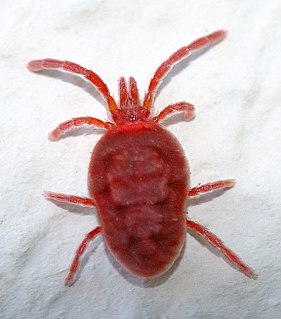
Mites are small arachnids.

The Acari are a taxon of arachnids that contains mites and ticks. The diversity of the Acari is extraordinary and their fossil history goes back to at least the early Devonian period. Acarologists have proposed a complex set of taxonomic ranks to classify mites. In most modern treatments, the Acari are considered a subclass of the Arachnida and are composed of two or three superorders or orders: Acariformes, Parasitiformes, and Opilioacariformes; the latter is often considered a subgroup within the Parasitiformes. The monophyly of the Acari is open to debate, and the relationships of the acarines to other arachnids is not at all clear. In older treatments, the subgroups of the Acarina were placed at order rank, but as their own subdivisions have become better understood, treating them at the superorder rank is more usual.

House dust mites are mites found in association with dust in dwellings. They are known for causing an allergy.

Tetranychus urticae is a species of plant-feeding mite generally considered to be a pest. It is the most widely known member of the family Tetranychidae or spider mites. Its genome was fully sequenced in 2011, and was the first genome sequence from any chelicerate.

The California sea hare is a species of sea slug in the sea hare family, Aplysiidae. It is found in the Pacific Ocean, off the coast of California in the United States and northwestern Mexico.

Spider mites are members of the Acari (mite) family Tetranychidae, which includes about 1,200 species. They generally live on the undersides of leaves of plants, where they may spin protective silk webs, and they can cause damage by puncturing the plant cells to feed. Spider mites are known to feed on several hundred species of plants.

The strawberry poison frog or strawberry poison-dart frog is a species of small poison dart frog found in Central America. It is common throughout its range, which extends from eastern central Nicaragua through Costa Rica and northwestern Panama. The species is often found in humid lowlands and premontane forest, but large populations are also found in disturbed areas such as plantations. The strawberry poison frog is perhaps most famous for its widespread variation in coloration, comprising approximately 15–30 color morphs, most of which are presumed to be true-breeding. O. pumilio, while not the most poisonous of the dendrobatids, is the most toxic member of its genus.

The Acariformes, also known as the Actinotrichida, are the most diverse of the two superorders of mites. Over 32,000 described species are found in 351 families, and an estimated total of 440,000 to 929,000 species occur, including undescribed species.
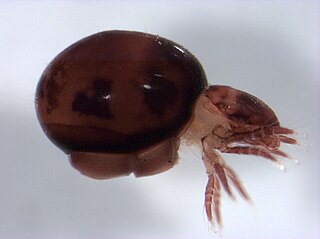
Oribatida, also known as oribatid mites, moss mites or beetle mites, are an order of mites, in the "chewing Acariformes" clade Sarcoptiformes. They range in size from 0.2 to 1.4 millimetres. There are currently 12,000 species that have been identified, but researchers estimate that there may anywhere from 60,000 to 120,000 total species. Oribatid mites are by far the most prevalent of all arthropods in forest soils, and are essential for breaking down organic detritus and distributing fungi.
Leptotrombidium is a genus of mites in the family Trombiculidae, that are able to infect humans with scrub typhus through their bite. The larval form feeds on rodents, but also occasionally humans and other large mammals. They are related to the harvest mites of the North America and Europe.

Trombiculidae are a family of mites. Chiggers are often confused with jiggers - a type of flea. Several species of Trombiculidae in their larva stage bite their animal or human host and by embedding their mouthparts into the skin causing "intense irritation" or "a wheal, usually with severe itching and dermatitis",
Austrophthiracarus is a genus of mites in the family Steganacaridae.

Phoresis or phoresy is a non-permanent, commensalistic interaction in which one organism attaches itself to another solely for the purpose of travel. Phoresis has been observed directly in ticks and mites since the 1700s and indirectly in fossils 320 million years old, but is not restricted to arthropods or animals. Plants with seeds that disperse by attaching themselves to animals are also considered to be phoretic.
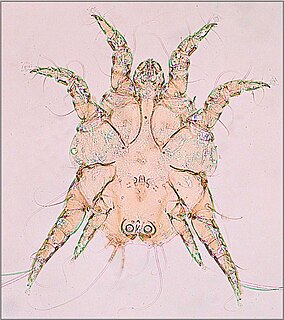
Mites that infest and parasitize domestic animals cause disease and loss of production. Mites are small invertebrates, most of which are free living but some are parasitic. Mites are similar to ticks and both comprise the order Acari in the phylum Arthropoda. Mites are highly varied and their classification is complex; a simple grouping is used in this introductory article. Vernacular terms to describe diseases caused by mites include scab, mange, and scabies. Mites and ticks have substantially different biology from, and are classed separately from, insects. Mites of domestic animals cause important types of skin disease, and some mites infest other organs. Diagnosis of mite infestations can be difficult because of the small size of most mites, but understanding how mites are adapted to feed within the structure of the skin is useful.
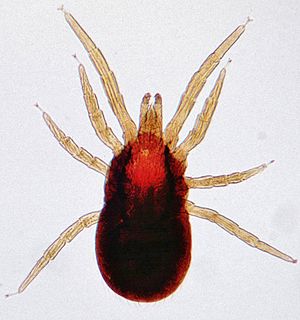
Mites are small crawling animals related to ticks and spiders. Most mites are free-living and harmless. Other mites are parasitic, and those that infest livestock animals cause many diseases that are widespread, reduce production and profit for farmers, and are expensive to control.
Neumania papillator is a water mite in the genus Neumania and is known in behavioural ecology as an example of sensory exploitation - males of this species hijack existing female sensory abilities for their own gain in courtship.
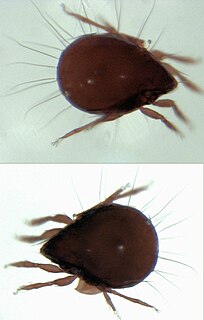
Oripodoidea is a superfamily of oribatids in the order Oribatida. There are about 19 families and at least 1,300 described species in Oripodoidea.

The UPLB Museum of Natural History is a natural science and natural history museum within the University of the Philippines Los Baños (UPLB) campus. It serves as a center for documentation, research, and information of flora and fauna of the Philippines. The museum is one of the research and extension units of the UPLB and its role parallels that of a library for written records.